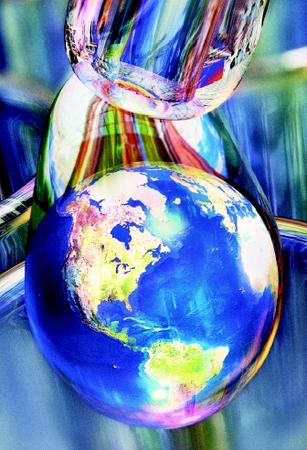In Earth's solar system, evidence of subsurface ice, ancient valley networks, and even an ancient ocean occurs on the planet Mars. Water ice
and perhaps liquid water occur beneath the frozen surfaces of three of
Jupiter's moons, although currently none have free surface waters.
But among the planets orbiting the Sun, Earth is clearly the "water planet." Water occurs on its surface as liquid, ice, and gas. Ocean
waters now cover nearly 71 percent of Earth's surface, whereas
fresh waters in lakes and rivers cover less than 1 percent. Thick ice
sheets permanently cover Earth's polar regions and
glaciers
are widespread in its higher mountains. Water in the form of clouds masks
about half of Earth's surface at any time. Volcanic eruptions
continually extract water and gases from rocks deep in Earth's
interior.
Early Earth
Water and gases from comets and meteors colliding with the early Earth are believed to have contributed to its ocean and atmosphere over many
billions of years. After intense and destructive meteorite bombardments
ended about 3.9 billion years ago, the present ocean and atmosphere were
formed. Most of Earth's surface water (97 percent) accumulated in
ocean
basins
, with lesser amounts (about 3 percent) forming thick ice sheets on what
are now Greenland and Antarctica. Only a small fraction of
Earth's water occurred in lakes, rivers, or mountain glaciers.
As living organisms evolved and became more abundant, they modified the composition of Earth's atmosphere. For instance,
photosynthesis
by plants contributed oxygen, making the evolution of animals possible.
Today, Earth's rich and diverse life forms depend on its abundant water. All life on Earth is thought to have originated in the ocean, and
today water makes up 60 to 70 percent of all living matter. About
two-thirds of the human body is composed of water. Humans can live no
more than a week without drinking water.
Water Movement on Earth
Earth's water moves in several cycles, each driven by different energy sources and acting over various periods of time.
Cycles Below Earth's Surface.
The slowest cycle affecting Earth's water movement is called
plate tectonics
. Powered by heat from Earth's interior, tectonic processes act
over millions and probably billions of years, slowly moving
Earth's crust to build continents and shape ocean basins (only to
be eventually destroyed).

percent of all living matter.
Volcanic and
metamorphic
activity associated with plate tectonics melts and extracts water and
gases from deeply buried rocks, and later releases them at
Earth's surface during volcanic eruptions. Volcanic activity also
supplied much of the ocean's salts. Sea water flows through
fractured, newly formed, hot volcanic rocks at mid-ocean ridges and
reacts chemically with them. The salts are discharged into the ocean.
Smaller amounts of salt are extracted from rocks on land, which have
been altered by
weathering
. Streams transport weathered rock fragments, sediments, and salts to
the ocean.
Compared to surface waters, less is known about water flowing through sediment deposits (e.g., sands and gravels) and through water-bearing
rock formations known as aquifers. These underground waters eventually
return
to the ocean by way of rivers and lakes, and through the submerged
edges of the continents. On a global scale, neither the amounts nor
rates of such
groundwater
flows are well known.
Cycles Above Earth's Surface.
Water moves more rapidly across Earth's surface in cycles powered by solar energy than water that moves at or below the surface. In a
process known as the
hydrologic cycle
, water evaporates from ocean surfaces warmed by energy from the Sun.
Most of the vapor condenses quickly and falls over the nearby ocean as
rain. Some water vapor travels farther to fall on land, and eventually
returns to the ocean by river discharges and also by discharges of
groundwater through the rocks and sediments of continental margins.
Winds blowing across the ocean set its surface waters in motion. The resulting surface currents flow primarily from east to west near the
equator. Elsewhere these surface currents form nearly closed patterns,
called
gyres
, centered in the subtropics. Stronger surface currents occur near the
ocean margins.
When ocean waters cool near the poles—especially in the Antarctic and North Atlantic Oceans—they become denser and sink below the
surface. There they flow slowly in sluggish subsurface currents toward
the equator, where they eventually return to the surface to be warmed
and to begin the cycle again. Such subsurface currents take many
hundreds of years to complete their cycle. These subsurface currents are
part of Earth's heating system, returning cool waters to the
tropics to be warmed again for the return flows in surface currents to
polar oceans.
Although sluggish subsurface ocean currents involve water movements measured over centuries, surface ocean currents move sea water across
ocean basins in time periods measured in years. Winds can transport
water vapor across continents in only a few days.
Views: 332
© 2025 Created by Aggie.
Powered by
![]()